
PM is celebrating a significant milestone this year, as it recognizes 100 years of publication, beginning with its debut as the City Manager Bulletin in January 1919. In each issue of 2019, we'll be bringing you highlights from the magazine from each decade.
From the December 2019 Edition

Craig Chavez wrote about how local governments were beginning to use the social media platform called Twitter. It’s interesting to read about how this time is described since Twitter has been around for a long time now and back then it was just starting to take off. Chavez writes, “That’s right, local governments have taken to tweeting. Residents can visit Twitter.com, create an account, sign up to their communities Twitter page and receive messages—140 characters—called ‘tweets’ from their local government.”
Rick Cole discussed what social media means for public managers and what potential use they could have for the new, emerging world of social media. Cole writes, “Web 2.0 has given us blogs, Twitter, YouTube, and Facebook, changing how we communicate and reshaping our social and personal lives. For local government managers, these social media offer new tools for one of democracy’s oldest challenges: promoting the common good.”
From the November 2019 Edition

Census 2000: Geographic and Address List Partnerships: Linda Franz wrote about the roles tribal, state, and local governments hoped to play in Census 2000. The article focused on the earliest partnership activities, geographic preparations, and the census address list.
Local Government Internet Policies: Kent County’s Experience: Dennis Marstall wrote about the hottest thing in local government at the time—the internet. He noted that the rush of local government to become part of this new frontier was enticing. However, many governments had failed to implement comprehensive internet policies for employees.
Detect and Prevent Antitrust Violations: Robert Connolly’s article focused on federal antitrust laws, which were enacted to preserve our system of free competition. He noted that due to a manager’s role in bids, quotes, and awarding of contracts, they are in a position to observe and identify violations of antitrust laws. The article gives tips on how to manage the local government procurement process, staying within the boundaries of the law.
From the October 2019 Edition
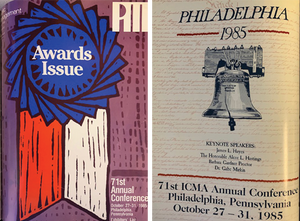
In the October 1985 issue, the awards, then called the "1985 ICMA Foundation Annual Awards," were being presented at the 71st Annual ICMA Annual Conference in Philadelphia, Pennsylvania. Chairman Bob Kipp wrote, “The ICMA Foundation is pleased to present the winners of the 1985 Annual Awards. The individuals and programs honored by these awards are testimony to the range of creative and effective solutions to the challenges now facing local government managers. The foundation was created in 1980 in the interest of supporting professional local government management by educational outreach and by support of individual administrators.” He continued, “All programs are funded solely by tax-deductible contributions, gifts, and grants. With this support, the foundation will attain greater visibility and effectiveness which can only benefit the membership and strengthen local government management. The foundation provides the opportunity to re-pay our debt to the profession to which we owe so much.”
A few of the awards included the Mark E. Keane Award for Excellence, the Local Government Journalism Award, the Clarence E. Ridley Award, and the L.P. Cookingham Award.
From the September 2019 Edition
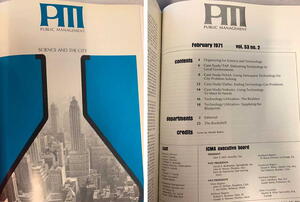
It’s always exciting to have a look at PM’s previously printed pages to have a peek into the past of local government news. In the February 1971 issue, a feature titled, “Technology SOS: What Cities Need,” lists a page full of samples of city problem statements prepared for the ICMA/NASA program. The feature lays out over 30 sample technology requests that would have improved cities at the time: “A vehicle with equipment to remove dirt and small debris from street surfaces. A soil stabilizer to use on unpaved roads and alleys. A device to measure the strength of concrete, which is in place and hardened, without destroying the concrete. A simple metering device that could be attached to a firefighter’s helmet or lapel, able to measure and sound an alarm when certain conditions exist.”
In another feature, “Ending Technology Use Problems,” urban scientist and PM author Dean Vanderbilt describes his work with the City of Dallas, Texas, and shares his thoughts on ways a city could organize to utilize scientific knowledge. He also predicts the future of scientists on city staffs and how their roles could evolve. Vanderbilt writes, “The range of municipal services has never been greater than today, and expansion takes place each year. Resources are limited and personnel costs, a large part of any municipal budget, are increasing rapidly.” He lists various issues that he believes can be solved with technological advances, as well as ways local governments can move these initiatives forward. Vanderbilt concludes with the idea that technology can be effectively utilized in solving community problems with the determined efforts of local governments.
Many of the statements made in both features are problems that have been fixed with the evolution of technology. It’s fascinating to see that even in the ‘70s, PM Magazine was looking toward innovation and technological advancement for cities.
From the August 2019 Edition
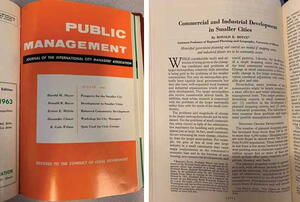
This issue also contained another “What Cities Are Doing” section filled with news from cities across the United States. For example, in Roseville, California, the city founded a municipal tree farm that began with an anonymous donation of 7,000 evergreen trees. The trees were planted in a portion of the land at the city sewage treatment plant, and the wastewater from the plant was used to irrigate the farm. The author wrote, “It is estimated that the city will incur almost no new costs in the opening of the farm. In addition to using the trees for the city street tree program, many of the trees will be used initially to landscape a new municipal golf course and a recently purchased park site.”
Another interesting news item came from Titusville, Florida. In 1963, by act of the state legislature, the cities of Titusville and Whispering Hills consolidated to form the new city of Titusville. The author writes, “In addition, the consolidated city includes the unincorporated area of the Indian River City and considerable territory.” The new land area would encompass 15 square miles and have a population of 18,000 residents.
The “Management Digest” section included columns about the role of businessmen in urban revitalization and management appraisal of conflicting human values. Both columns were also published in the May–June 1963 issue of the Harvard Business Review.
From the July 2019 Edition
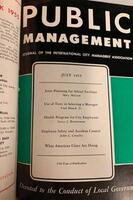
It is interesting to look back and see what PM’s contributors and editor deemed crucial to include on these early covers to get their message across to readers. The “What American Cities Are Doing” section informed readers about city priorities in the 1950s. For example, under “Envelope Advertising,” the author writes, “More cities are making use of the message-carrying potential of the outside of envelopes in which they mail letters, bills, and general announcements. Most of the messages are intended for local viewing and vary from ‘You Separate – We Incarcerate’ on Hartford, Connecticut, envelopes to Fort Smith, Arkansas, ‘City Business is Your Business – Have You Seen About It?’”
Under “Federal Aid to Clear Slum Area,” the author writes about federal funds approved to aid Danville, Virginia, in clearing a downtown slum area to accommodate the expansion of the city’s central business district. The author writes, “The action allocates a loan of $478,277 and a capital grant of $95,277 to aid in the clearing and preparing for redevelopment of a blighted 10-acre residential area.” The most interesting part of this story is that the estimated net cost of this project was $152,127, which represented the difference between the cost of acquiring and preparing the land for redevelopment and the return from resale of the improved land for redevelopment.
The July 1955 issue makes it clear that the content in PM has remained consistent throughout the years. The goal was, and continues to be, providing quick and informative reading curated for local government professionals.
From the June 2019 Edition
In the April 1943 issue, under “What American Cities Are Doing” the problems that local governments were tackling become evident. In a bulletin titled, “Canteen for Children of War Workers,” the author announced that Detroit had opened a children’s canteen to provide after-school and Saturday care for 6-to-12-year-olds whose mothers worked in the war plants. It read, “Boy and Girl Scouts will meet the youngsters at the close of school and escort them to the canteen where they will be entertained with games, gymnastics and story-telling and given a hot supper.” It also stated that the charge for the children attending the canteen all week, including Saturday, would amount to $2.50.
From the May 2019 Edition
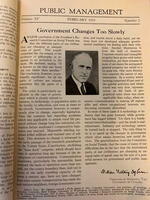
In the May 1933 issue, the “News of the Month” section included a bulletin announcing that seven cities had adopted a five-day work week for city employees. “Seven cities of over 50,000 population have restricted hours of labor and days per week according to a recent report published but the United States Conference of Mayors.”
The PM issues in the 1930s touched on many relevant topics of the time. In the May 1934 issue, Julia Wright Merrill described how the depression had affected public libraries: “Reduced availability of new books and magazines, shorter hours, deterioration of book stock, salary cuts, discontinuance of training classes and an over-worked staff are the chief ill effects suffered by libraries.”
From the April 2019 Edition

- It was reported that the “January Bulletin was drafted by stub pencil on scratch paper aboard a train. The idiosyncrasy chirography is more to be blamed than our mimeographer for the frequent errors noted.”
- A position appointment was noted as a “managership.”
- In January 1923, City Manager Magazine, the successor of the City Manager Bulletin and labeled the official organ of the City Managers’ Association, is published from Lawrence, Kansas. Advertising is accepted for sewer flushing siphons, chloride of lime, and vitrified paving brick.
- Articles focused on such topics as paving widths, useless expenditures, creamery wastes disposal, public welfare department organization, and local government management in New Zealand.
- Concerns also focused on ice plants (1923), standardized fire hose couplings and a municipally owned autobus (1924), and truant gangs (1925). At the end of 1920s, articles were published on airports as a city problem, street assessment collection, administrative organization, and cost accounting.
From the March 2019 Edition

Issues of the day could be found in managers’ statements like this one: “Harry Freeman of Kalamazoo advises that he finds morning conferences of administrative officials very valuable. City distribution of milk, city planning, budget exhibition, and a municipal bulletin are on the slate for 1919.”
Another statement found among the first pages: “ICMA members and ex-managers who have been in the Service are looking about for opportunities to return to the field.”
The February 1919 copy included a list of city manager salaries, which would later become content for ICMA’s Municipal Year Book. Some of the 1918 salaries shown: Niagara Falls, New York ($5,000); Glendale, Arizona ($2,400); Cadillac, Michigan ($2,200); and Hickory, North Carolina ($1,500).
From the January/February, 2019 Edition
This issue includes messages from two respected ICMA members who, over the years, also have been PM contributors and readers.

My Regards to PM
I think so much of the ICMA organization and of Public Management (PM) magazine. I go back a long way with ICMA—to former executive directors Clarence Ridley, Orin Nolting, Bill Hansell, Mark Keane, my idol Bob O’Neill, and now Marc Ott. The organization, along with the magazine, has meant a great deal to me throughout my career, and I have tried to give back a little by contributing to both while as a manager and at the LBJ School in Austin.
I particularly enjoy reading Public Management for (1) the insightful articles penned by motivational and leadership writers—and not incidentally, current ICMA staff members—who constantly challenge managers and others of us who work in a number of professions, and (2) the columns and articles by current managers who give us the benefit of how they face and solve the everyday problems that all communities face.
I am holding out for the ICMA conference in San Antonio in 2023 to celebrate my 100th birthday in my favorite city. Congratulations to PM for reaching its 100th milestone in 2019!
Y’all keep ginning out PM. It’s the best trade magazine in the world, and I still look forward to receiving it every month!

PM Reflections
Congratulations to PM on its 100th year of publication. For my formal city management education, I relied on the Fels Institute of Government at the University of Pennsylvania. That education was thorough and contained many managerial and supervisory instructional exercises.
But for most of my management processes and practices training, I depended on articles in PM. Those articles had stories of work projects that had beginning and ending explanations. The stories told how it was done and what was the level of success and/or failure.
Invariably, the stories told of the involvement of elected officials, department personnel, community organizations, and individual residents. And the stories’ authors were usually people you could pick up the telephone and query directly. I gained a lot personally from having PM as a tool.
I regularly referenced PM during executive staff meetings in each of the cities I served as administrator or managed: Inkster, Michigan, 1970–1973; Ann Arbor, Michigan, 1973–1979; Cincinnati, Ohio, 1979–1985; and San Diego, California, 1985–1986.
I also used the magazine as a training tool for city employees. I especially remember using it with the middle management training sessions in the city of Cincinnati. The Personnel Training Division usually copied it for training classes, and I certainly referred to it when I spoke to the classes. We were able to improve our work product in Cincinnati based on articles we had read.
A BIG SALUTE TO PM!

New, Reduced Membership Dues
A new, reduced dues rate is available for CAOs/ACAOs, along with additional discounts for those in smaller communities, has been implemented. Learn more and be sure to join or renew today!
